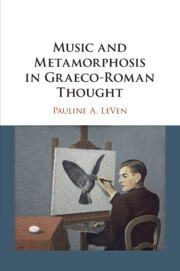Book contents
- Music and Metamorphosis in Graeco-Roman Thought
- Music and Metamorphosis in Graeco-Roman Thought
- Copyright page
- Dedication
- Contents
- Acknowledgments
- Abbreviations
- Introduction
- Chapter 1 Forest: On Surrounds
- Chapter 2 Ringdove: On the Uncanny Power of Performance
- Chapter 3 Cicadas: On the Voice
- Chapter 4 Echo: On Listening
- Chapter 5 Reeds: On Musical Objects
- Chapter 6 Nightingale: On Expression
- Chapter 7 Beetle: On Rhythm
- References
- Citations Index
- Subject Index
Chapter 7 - Beetle: On Rhythm
Published online by Cambridge University Press: 25 November 2020
- Music and Metamorphosis in Graeco-Roman Thought
- Music and Metamorphosis in Graeco-Roman Thought
- Copyright page
- Dedication
- Contents
- Acknowledgments
- Abbreviations
- Introduction
- Chapter 1 Forest: On Surrounds
- Chapter 2 Ringdove: On the Uncanny Power of Performance
- Chapter 3 Cicadas: On the Voice
- Chapter 4 Echo: On Listening
- Chapter 5 Reeds: On Musical Objects
- Chapter 6 Nightingale: On Expression
- Chapter 7 Beetle: On Rhythm
- References
- Citations Index
- Subject Index
Summary
The kerambyx is a paradox. Now a near-silent insect (a stag beetle, lucanus ceruus), it used to be the most musical man of his time, Kerambos. While the kerambyx is still omnipresent in the countryside all over Europe, the mythical shepherd Kerambos is virtually absent from all Greek and Roman texts; Kerambos’ story is only preserved in the passage quoted above and in a short passage of Ovid’s Metamorphoses. The myth is also different from many other musical myths, and from the ones I have examined so far: in a reversal of the Procne story read in the , where a woman turns into the most musical of birds, a most musical man here becomes an insect whose sounds are barely accessible to human ears. The creature that results from the transformation does not keep any of the characteristics of the used-to-be-human. Finally, the narrative seems to say nothing about music, except to explain the visual aspect of the insect, whose head resembles a lyre. It is no surprise then that the kerambyx has not been adopted into the big musical family that includes crickets, katydids, and cicadas, whose musicality is celebrated all over Greek and Latin literature. The kerambyx instead introduces a much more disquieting presence, one haunting the Kafkaesque imagination.
- Type
- Chapter
- Information
- Music and Metamorphosis in Graeco-Roman Thought , pp. 206 - 231Publisher: Cambridge University PressPrint publication year: 2020

